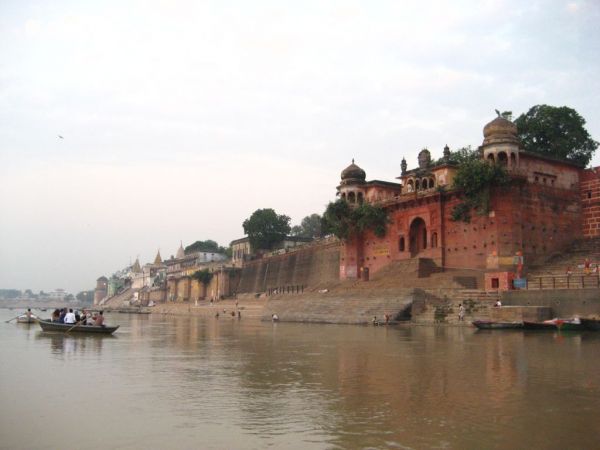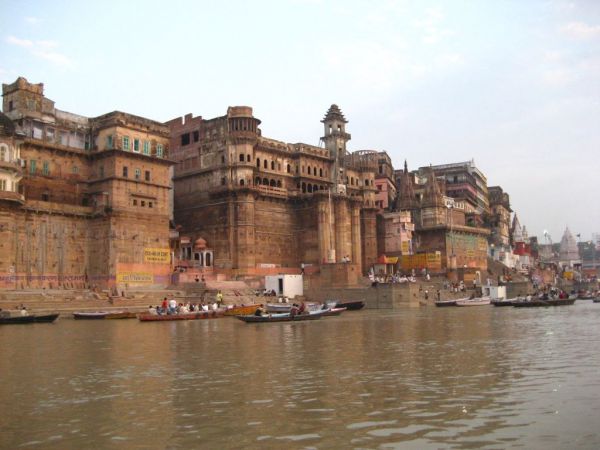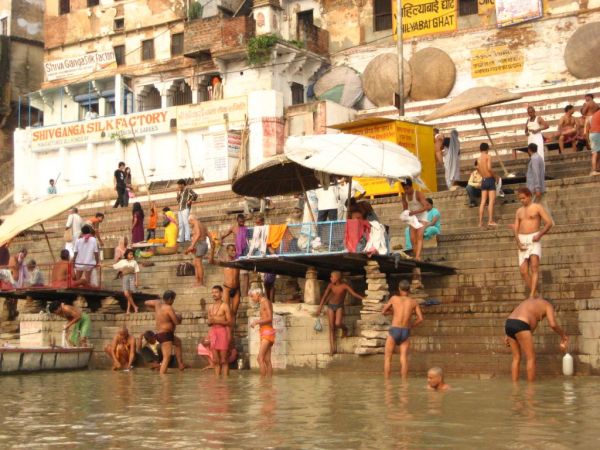The Ganges takes the shape of a crescent. One bank abandoned to the nature, one bank dedicated to the religious fervour.
Varanasi, bathed by the sacred river of the Hinduism and its followers' fervour.
Enjoying a sunrise over the holy city from a small boat drifting on the waters, and you'll surely feel this sensation that overloads your senses, this religious tradition which pierces you to the sound of the morning prayers and at the pace of the ancestral rites several generations of Hindu people perpetuate coming to purify and revitalize themselves into the river.
The bank is a string of ghats, stone stairways arise in the parallel alleyways of the river and vanish below into the holy waters. 5h30, in the coolness of the dawn, we go down a few steps and sit down in a wooden boat. The gondolier pushes off the bank and we start sailing on the waters reflecting the glow of the dawn. A cathedral silent in this Hindu open-air temple. The sun rises beyond the pristine bank and lights the polychrome façades of the opposite bank. We "swim" in this scenery up to be intoxicating. Our digital cameras immortalize these moments of life. Thousands of pilgrims give to each one of these moments a unique and unforgetable feature. An ochre and saffron postcard.
























Keyword - resting -
Saturday 13 October 2007
Hindu fervour by the Ganges river
By dorian on Saturday 13 October 2007, 22:06 - RTW-India
Tuesday 9 October 2007
On a dromedary's back in the Thar desert
By dorian on Tuesday 9 October 2007, 22:54 - RTW-India
The stone castle dances in the desert wind of the Rajasthan. These thick bulwarks carry a bloody, more or less glorious past within their bowels. The fort of Jaisalmer knew its moments of prosperity, at the thriving time of the silk roads. Vendors of every kind sold their textiles, spices, elixirs and miraculous products. But the development of the maritime saling in the south of India suddenly shattered the opulent prosperity of the city nestled on the edge of the Thar desert. It had to wait for several centuries before some backpackers rediscover the serenity of this small hamlet overlooked by lofty ramparts. Sensing the fledgling market, a great deal of inhabitants turned towards this new type of modern business, the tourism. To the point to spoil the old buildings, from now on being weighed down with signs utterly dedicated to the tourists.
The touts fidget as soon as we get off the train and are omnipresent in the city. Up to lose patience several times. The inebriating alleyways within the ramparts are dotted with souvenirs shops and snake among sable-hued delicately chiseled buildings. Jaisalmer epitomizes Rajasthan where the time seems to get fixed. Most of tourists come here to enjoy riding a dromedary and sleeping on the sand dunes of the Thar desert.







We leave for a 3-day meharé in the desert. The jeep draws away the fort of Jaisalmer while a swarm of windmills whril in the glowing morning sky.

A short stop at the royal cenotaphs and we take our way again. We plunge into the flat and dry roads of the desert.




On the edge of the road, 2 heavily loaded dromedaries wait for their hosts. We make Badia's acquaintance who will guide us throughout this stroll in the desert.
We sit astride the animals and with a slow and gentle pace we leave to the unknown. The dromedary is not really comfortable. We often stop to get over our trials. We take advantage of the stops to watch this fascinating animal able of staying 2 weeks without drinking and then swallowing 200 liters of water within 3 minutes. The soles of their leg cushion the heavy carcass when the long bend neck swings at the rate of the steps. A timeless experience while we reach a bit of sand dunes where we get off the animal to spend the night. We run onto the sandy mounds. A magical sensation of the feet which sink into the blong sun-heat sand. We sit down on the crest of a dune, vague look and fixed mouth. These desert wind-shaped landscapes penetrate and mesmerize us. We share the diner in a deep silence and dash to settle a pile of blankets up a dune. Lying down on the sand area and the eyes skywards, the star-dotted sky shows our pettiness. Without being able to say anything, our looks peer into the sky, endeavour to piece the constellations together, capture the fleeting apparition of a shooting star or the slow trip of a satellite. We fall asleep as in a dream, a dream full of stars.








We sit astride our mounts for a long stroll, far from all. We start again our slow drift towards the inknown et lose the notion of time and space. Bushes and small trees immortalize the few signs of life that surround us and mark a set of dunes out. Without comparison with the Sahara infinity, the sunset over the dunes of the Thar desert remains poignant. The golden disc vanishes in the distance, the bronze shades darken and the first stars break through the celestial vault. A second magical night lying down on a dune, the hands crossed under the head and the eyes getting the light of these millions of stars and galaxies that slowly turn around the polar star. Silence and admiration.















Third and last day of our stroll and our dromedaries drop us off at the edge of the asphalted road where a jeep waits for us to go back to the fort of Jaisalmer.
A break in the desert utterly out of time and completely invigorating.
Sunday 30 September 2007
Buddhist wisdom near Dharamsala
By dorian on Sunday 30 September 2007, 11:23 - RTW-India
It's hard to sleep on the winding and bumpy roads of the Himachal Pradesh. We finally pull in at 5 o'clock in the morning at MacLeodGanj. We go for finishing our night in a faraway guesthouse, lost at the end of a dusty alleyway.
Not far from Dharamsala, MacLeodGanj is the haven of many Tibetans whose dalai lama, the most well-known among them. The tibetan exodus started in 1950 while the Chinese invaded their homeland. A museum reminds the struggle of fundamentally pacifist people and brutally repressed by the Chinese army. The catastrophic result sends a chill down our spine. The systematic destruction of the monasteries and temples reached the frightening number of 90%. More than one million of Tibetans passed away and several ones fled despite the harsh conditions of the Himalaya crossing. A pacifist solution seems hard to find so that Tibet gets its independence back. And the Chinese keeps on carrying out the "sinization" sending millions of Chinese to live in Tibet, to such an extent that, from now on, Tibetan are minority in their homeland.
MacleodGanj is a haven, a welcoming land for this thousands of Tibetans in exile. Refugees wishing more than all going back to their occupied country. We stop in front of the humble dalai lama's dwelling. Followers and onlookers huddle together to see him, shake his hands or take part in a collective meditation session.







We won't have time to meet him and leave the place hopping on a morning bus to Amritsar, capital city of a remote but symbolic religion, the Sikhism. At the India scale, a few hours from Dharamsala, religious capitals meet in the tolerance and the mutual respect.
« previous entries - page 5 of 7 - next entries »



